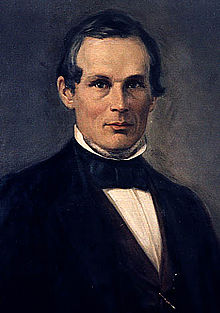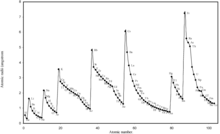Angstrom
The angstrom (symbol Å) is a unit of length used mainly to express wavelengths, molecular and atomic distances, etc. It is represented by the letter Å.
It is a unit of measurement equivalent to one ten billionth of a meter: 0.000 000 000 1 meters. One centimeter holds one hundred million angstroms.
Its name comes from the Swedish physicist Anders Jonas Ångström.
- 1 Å = 1 × 10-10m = 0.1 nm
Angstrom is often used in natural sciences and technology to express sizes of atoms, molecules, microscopic biological structures and chemical bond lengths, arrangement of atoms in crystals, wavelength of electromagnetic radiation, and the dimensions of the integrated circuit parts. The atomic (covalent) radii of phosphorus, sulfur, and chlorine are about 1 angstrom, while that of hydrogen is about 0.5 angstroms. Visible light has wavelengths in the range 4,000–7,000 Å.
At the end of the 19th century, spectroscopists adopted 10-10 of a meter as a convenient unit to express the wavelengths of the characteristic spectral lines (monochromatic components of the emission spectrum) of the chemical elements. However, they soon realized that the definition of the meter at the time, based on a material artifact, was not accurate enough for their work. So, around 1907, they defined their own unit of longitude, which they called "Ångström", based on the wavelength of a specific spectral line. meter in the same way, that the angstrom returned to be equal to 10-10 meter.
Although a decimal power fraction of the meter, the angstrom was never part of the SI system of units, and has been increasingly replaced by the nanometer or picometer. Until 2019 it was listed as a compatible unit by both the International Bureau of Weights and Measures (BIPM) and the National Institute of Standards and Technology (NIST) of the United States, but it is not mentioned in the 9th edition of the official SI document, the "BIPM Brochure" (2019) or the NIST version thereof.
The 8th edition of the BIPM brochure (2006) and NIST guide 811 (2008) used the spelling ångström, with Swedish letters; however, this form is rare in texts in Spanish. Some popular US dictionaries only list the spelling angstrom.
The accepted symbol is "Å", regardless of how the unit is spelled. However, the "A" it is often used in less formal contexts or in limited typographical media.
History
In 1868, Swedish physicist Anders Jonas Ångström created a chart of the spectrum of sunlight, expressing the wavelengths of electromagnetic radiation in the electromagnetic spectrum in multiples of one ten-millionth of a millimeter (or 10−7 of mm). Ångström's graph and table of wavelengths of the solar spectrum became widely used in the solar physics community, which adopted the unit and named it after him. Later it spread to the fields of astronomical spectroscopy, atomic spectroscopy, and then to other sciences dealing with structures on an atomic scale.
Although it was intended to correspond to 10-10 meters, that definition was not precise enough for spectroscopy work. Until 1960, the meter was defined as the distance between two scratches on a platinum-iridium alloy bar, kept at the International Bureau of Weights and Measures (BIPM) in Paris in a carefully controlled environment. Reliance on that standard material had led to an initial error of approximately one part in 6000 at the tabulated wavelengths. Ångström took the precaution of having the standard bar he used checked against a Paris standard, but the metrologist Henri Tresca reported that it was so incorrect that Ångström's corrected results had more errors than his uncorrected ones.
In 1892-1895, Albert A. Michelson and Jean-René Benoît, working at the BIPM with specially developed equipment, determined that the length of the international standard meter was equal to 1553163. 5 times the wavelength of the red line of the emission spectrum of electrically excited cadmium vapor. In 1907, the International Union for Cooperation in Solar Research (which later became the International The Astronomical Union) defined the international angstrom as exactly 1/6438.4696 of the wavelength of that line (in dry air at 15 °C (hydrogen scale) and a pressure of 760 mmHg for a value of gravitational acceleration of 9.8067 m /s2)..
This definition was approved at the 7th General Conference on Weights and Measures (CGPM) in 1927, but the material definition of the meter was retained until 1960. From 1927 to 1960, the angstrom remained a secondary unit of length for its use in spectroscopy, defined separately from the meter. In 1960, the meter itself was redefined in spectroscopic terms, allowing the angstrom to be redefined as exactly 0.1 nanometers.
Although still widely used in physics and chemistry, the angstrom is not a formal part of the International System of Units (SI). The nearest SI unit is the nanometer (10−9 m). The International Committee for Weights and Measures officially discouraged its use, and does not even mention it in the 9th edition of the official standard (2019). The angstrom is also not included in the European Union Catalog of measurement units that can be used in its internal market.
Angstrom asterisk
After the redefinition of the subway in spectroscopic terms, the Angstrom was formally redefined as 0.1 nanometers. However, for a time it was thought that a separate unit of comparable size was needed directly defined in spectroscopic terms. In 1965, J.A. Bearden defined the Angstrom asterisk (symbol: Å*) as 0,202901 times the wavelength of the line κ κ α α 1{textstyle kappa _{alpha1}}. This auxiliary unit intended to have a precision of 5 parts per million of the derivative version of the new metro. At the end of ten years, the unit had been considered both insufficient (with precisions closer to 15 parts per million) and obsolete due to the most accurate measurement equipment.
Other equivalencies
One millimeter contains ten million angstroms.
- 1 Å = 0.0001 μm, that is, the ten thousandth part of a micrometer.
- 1 Å = 0.1 nm, that is, the tenth part of a nanometer.
- 1 Å = 100 pm, that is, a hundred times a picmeter.
The angstrom and the international system of measurements
The angstrom is not a unit of the international system of measurements. However, it is considered as one of the useful units to respond to specific needs of certain technical scientific fields. The publication The International System of Units (SI) of the International Office of Weights and Measures, edited by the Spanish Metrology Center, available electronically, includes it in Table 8 (Other units not belonging to the SI), and says:
Angstrom is widely used in postitron crystallography in analytical chemistry because all chemical links are in the range from 1 to 6 angstroms. However, angstrom has not been officially sanctioned by the CIPM or by the GFC.
and on its use it advises that certain non-SI units still appear in scientific, technical and commercial publications and that they will continue to be used for many years. However, he also points out that scientists should be free to sometimes use such units if they see fit, although the inclusion of such units in their texts does not imply a recommendation for their use.
Contenido relacionado
Photoelectric cell
Schwarzschild radius
Heisenberg's uncertainty relation



